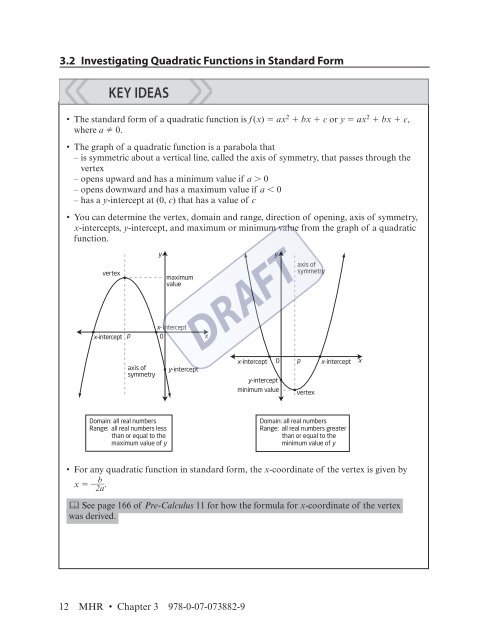Pre-Calculus 11 Workbook - McGraw-Hill Ryerson
Pre-Calculus 11 Workbook - McGraw-Hill Ryerson
Pre-Calculus 11 Workbook - McGraw-Hill Ryerson
- No tags were found...
You also want an ePaper? Increase the reach of your titles
YUMPU automatically turns print PDFs into web optimized ePapers that Google loves.
3.2 Investigating Quadratic Functions in Standard FormKEY IDEAS• The standard form of a quadratic function is f (x) = ax 2 + bx + c or y = ax 2 + bx + c,where a ≠ 0.• The graph of a quadratic function is a parabola that– is symmetric about a vertical line, called the axis of symmetry, that passes through thevertex– opens upward and has a minimum value if a > 0– opens downward and has a maximum value if a < 0– has a y-intercept at (0, c) that has a value of c• You can determine the vertex, domain and range, direction of opening, axis of symmetry,x-intercepts, y-intercept, and maximum or minimum value from the graph of a quadraticfunction.vertexymaximumvalueyaxis ofsymmetryx-interceptpx- intercept0xaxis ofsymmetryy-interceptx-intercept 0y-interceptminimum valuepvertexx-interceptxDomain: all real numbersRange: all real numbers lessthan or equal to themaximum value of yDomain: all real numbersRange: all real numbers greaterthan or equal to theminimum value of y• For any quadratic function in standard form, the x-coordinate of the vertex is given by__x = – b2a.& See page 166 of <strong>Pre</strong>-<strong>Calculus</strong> <strong>11</strong> for how the formula for x-coordinate of the vertexwas derived.12 MHR • Chapter 3 978-0-07-073882-9

















